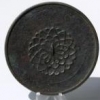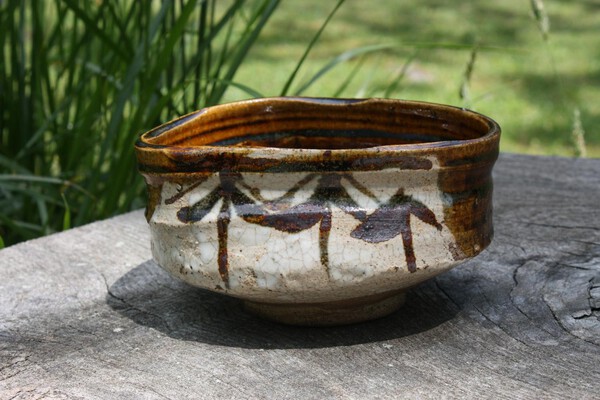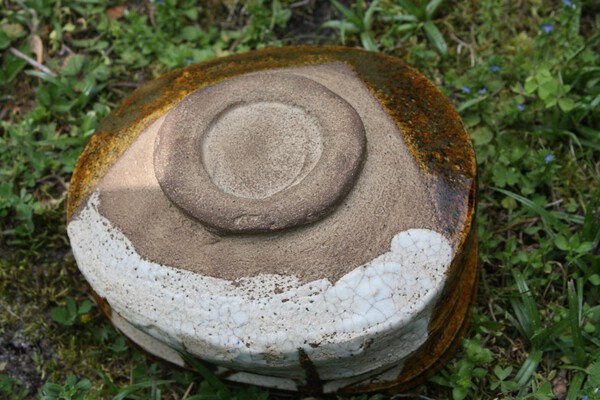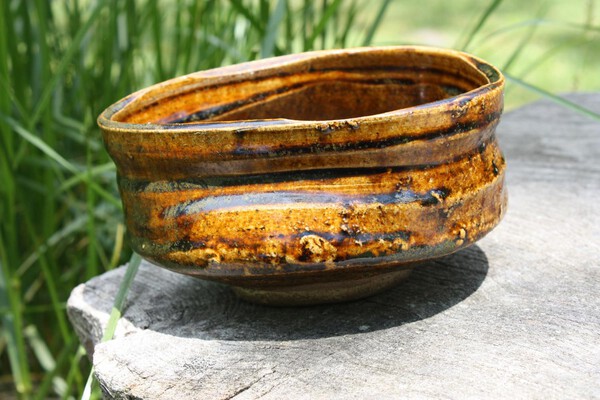-
Posts
290 -
Joined
-
Last visited
Everything posted by johnnyi
-
Excellent point John! johnnyi
-
I was under the impression Grant, that TL testing is limited to pottery? I suppose the least destructive way to limit damage is to limit testing to shards or damaged pieces (from particular location to get an idea how old an accompanying undamaged piece might be.) If a tiny amount of clay has to be removed from the foot of a sound piece it may be that determining age could insure that such a piece will be treasured and preserved rather than ignored. It is a case by case thing I would guess. Here is a link which might be helpful, and suggests Oxford as one place to inquire about this. daybreaknuclear.us/bortolot_faq.htm
-
Hi Evan, your knowledge is clearly vastly superior to mine regarding Oribe bowls. I have attempted to compare many pieces (through pictures, as I have no access and probably won't to genuine old ones). My results seem to have been futile which is why I posted. My novice observations are, a thin lip, a brownish gold glaze both of which I thought were curious. Beyond that what else stands out? . Can you be more specific regarding "throwing and glazing and execution"? Anything would help in understanding, (help all of us maybe who thought there was a slim chance it was possibly older), i.e. brush stroke?, glaze composite?, type of clay?, foot?, that make it vastly different from early edo . The bowl went very cheaply by the way, and I bought it to drink tea out of, so whatever age it is not all that important to me except to learn. It is curious though why someone evidently versed in chawan, would sell this as a 400 year old piece and turn off many prospective buyers in the process, rather than just offer it as (imho) an undated beautiful bowl and get some solid bids. Go figure. Thanks again, Regards, John
-
Thank you fellows for all your helpful comments, and thank you Robin for the link to the other "forum" (done in the spirit of Santa from "Miracle On 34th Street" who sent folks to Gimbals). I found this other article last night. It might lend a little weight to the possibility of locals making a cottage industry of digging "new-old" artifacts from this area. I could also see why few people would gamble on authenticity of pieces like this when you've got to shell out $400 to prove or disprove. Here's the link which alludes to what we're talking about. https://jigsaw-Japan.com/2019/02/16/shakado-museum-of-jomon-culture-really-digging-back-in-time/?fbclid=IwAR1pIa-ljgR8Fr4az0ziccMclLObp0jZ7LdiSz-LtVnmwkT1h2p6-CtOFa8 johnnyi
-
p.s. please don't worry about offending with negative comments if there is a reason for them. I am just trying to learn here. Thanks, J
-
Hello. This chawan came in the mail today. I'm hoping to gain some insights from some of you regarding who might have made it and when was it made. It was presented as coming from a "storehouse which, during the 1990's Japanese Olympics, was uncovered when constructing a highway" (and thus looks untouched.) It was also mentioned that these were accumulated by farmers at this time, many of them broken. This information was also added, "All four pieces I had TL-tested (Cost about $ 400 per piece) have confirmed an age about 400 yrs =/- 20%.". I have not the knowledge to doubt this might all be true, however my not knowing the seller, coupled with the bowl's immaculate condition give room for doubt. If it was new, who would be making these? (and so well?) I haven't seen another yet of this quality but I'm a novice, and have not seen enough. I'm hoping someone here can enlighten me on what I've got. (the Chawan is large, 147.3 mm and whatever age it might be I really like it). Thanks for your comments, Johnnyi
-
I've never found anything worthwhile in a junk box Brian, but I did dig these out of the ground back in 1990. I wrote a little article about them then at a time when a tsuba was a "sword guard" and a tsuka was a "sword grip" . I dug these at an 1850's lime kiln in Bucks County. The first find was the tsuba which was about 8" down under tree roots (almost discarded it, as it was crusted with rust....rust which would quickly brush off the fine iron). It took two years in all to find everything, and I never did find the blade. I'd imagined a scenario which might have made sense, had I not through pure serendipity (years after article was written) bumped into a fellow who, after us conversing on treasure, told me of the sword he'd found with his brother back in the fifties. How it was in an old trunk thrown into the ravine near the lime kiln, and how they spent the day hurling it at trees and generally doing what boys do. As to the blade, it was carted home to be seen no more. The tsuba, which you will occasionally see cheap reproductions of, is according to Christies, early Edo. Someday I may clean it, but I'm happy with it as it is for now. I don't know the dates of the other fittings, but the leaves do appear to be pure gold and the two piece habaki is solid silver. As to the location, apparently the nearby farms used the ravine adjacent to the kiln as a dump during and immediately after WW2. Thanks for looking, Johnnyi
-
You want stems? Here are stems. Stems, long leaf wrapping, shaped like daikon, and CORD. Now I rest my case. Cheers, Johnnyi
-
Another example where the tops of the leaves are not folded over. Could be to celebrate "Kodomo no Hi" or maybe offering to the Bean Moon?. regards, johnnyi
-
Again, if you look closely you will see these are not daikon, although the shape at a distance somewhat resembles the daikon's shape. These are long slender leaves wraopped in twine. There multiple stems are tied tightly as are their tops. They are accompanied with what appears to be oak or maple leaves probably to denote seasonality. Undoubtedly they were used to wrap food, possibly dumplings. imho johnnyi
-
Would not a daikon come to a point? Maybe it is one, but to me it resembled a bunch long leaves that are gathered and bound with cord, as there are leaves on one end and multiple stems on the other. See a somewhat similar motif of "ricecracker's called autumn leaves. johnnyi?
-
Wonderful article Peter. Now I understand your dismay over the date of the "Nobumasa" Johhnyi
-
Thanks for the invaluable help on this Peter, Curran, and Steven, and I apologize Gethin, for a probable imposter tsuba hijacking your post. Best of luck on getting yours papered. John
-
Hi Curran, I have always wanted to get it checked out also. Although I don't (want to) believe the signature was "added" (there is a lower punch mark on the nakago ana which slightly deforms the last stroke, seeming to indicate the signature was there before it was mounted), it is the reasons stated; that it seems to predate a known style that demands a cautious look. Yet, looking through M.Sesko's "Nobuie" book last night I see several other kind of whacky tsuba I would not have expected, (number 129 in the first group of rubbings for instance, though that might be reaching) When you say, "the finish" to the signature, please what exactly does that mean? Thanks, John
-
Thank you Christian and Peter. Here is the whole guard. (I will take a better picture tomorrow) Johnnyi
-
Pete, I definitely think Gethin should send his in and I'll send mine in too. J.
-
"Tensho three" (1575) thank you member Uwe Sacklowski Regards, Johnnyi
-
Dear Uwe, thank you very much for your help! Johnnyi
-
Hello, I have this tsuba posted under the tsuba section but I am asking here if anyone can translate the entire mei please. It appears to be Nobumasa but the rest I do not know for sure other than I remember it including a 1500's date. Thank you in advance for your help Regards, Johnnyi
-
Hi Pete. Yes, they do seem to be different makers. Mine was identified as the earlier Nobumasa due to the 1500's date . I regret I don't have the translation of the entire tsuba anymore, but would you or somebody else be able to translate the entire mei please? Is there anywhere a clear photo of the Oeder example, as the catalogue photo shows nothing. regards, John
-
Hi Gethin. really nice find! Here is my example of Nobumasa. I also have been looking for a while , but other than the Oeder collection (kindly pointed out to me by our member Christian M.) this example of your'[s is the only other one I've seen. . Your discovery provides the first time I think to actually to compare signatiures, as the Oeder picture is too poor as you know. Kind regards, Johnnyi
-
I vote Nara too. I seem to remember Mr. Haynes saying that seppa dai like this which are partially but not completely raised are a feature of Nara. ? johnnyi
-
Gentlemen, thanks for your input. I think it is going to come down to what can cause this specific state of the sukashii walls, (acids, salts, etc.) and it will probably take a metallurgist to answer this. I'm skeptical about this piece, but too early to write it off I guess. Thanks again Johni



















